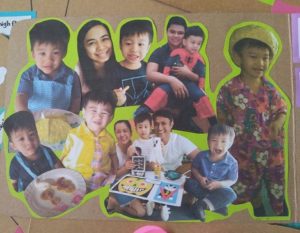
In my second year of teaching, I worked as the Head Teacher of a small preschool. I had a morning class with four students and an afternoon class with three, all aged two to three years.
My lessons had monthly themes like October was UN month. We had imaginary voyages and went to different countries, learned a dish, an art, or a literary piece while simultaneously learning about letters. Math, Science, Music and Arts concepts were incorporated in other lessons.

Because it was a small school, dismissal time meant being able to talk to my students’s parents who were enthusiastic to hear about their child’s performance, and had an open heart when it came to teaching techniques and practices which they can do at home. This will help reinforce and further concretize their child’s newfound concepts learned at school.
I had a student whose finger grip was good when it came to gripping a crayon but needed to improve on coloring with control and inside the line and writing his name independently. I advised his mother to practice coloring and writing more at home and they did make it a fun bonding moment for them which helped my student have more confidence at school.

For my student who displayed advanced communication skills compared to other classmates and had good memory when it came to details of a story, I advised his parents to develop their child’s love for reading.
Putting sight word as labels to different items in the house such as furniture could be a good way for a child to foster reading and spelling skills. I was proud to hear my student spell ‘table’ and ‘door’ in class.

Getting younger students to say goodbye to their moms when class is about to start could prove to be a challenge in the beginning. It was my duty to greet every student enthusiastically, to talk to them happily, and motivate the students to talk among each so that they can feel that school is a fun place where everyone is friendly and kind.
It also helps that my student’s parents do a good job of communicating to them that school is a fun place and they will be there after school to pick them up after a wonderful learning day. I especially like some parent’s techniques of giving a child a reward if they are able to relay what they did at school which also strengthens their speaking skills.

After playing with blocks, cleaning up, singing the ABC phonics song and the weather song, I ask my students to sit in criss-cross apple sauce style and play a game to catch their attention before lesson starts.
I begin by saying ‘macaroni and cheese, everybody freeze’ to get their attention and play a game of animal sounds. I would ask, ‘What does a cow sound like?’ and of course my very bright students go ‘Moo!’ and then I joke and say, ‘Doesn’t a cow go meow…meow…?’ and my students would burst laughing at the absurdity.
Incorporating jokes in learning is a good way to for students to recognize the contrast between what is true and what is ridiculous.

I am proud that my student’s parents do a good job of reminding their child to say polite phrases at home so that when they are at school, they exemplify respect and kindness toward their teacher and their other classmates.
A touching gesture from one of my students was when he thanked me and gave me a big hug as he said goodbye before going home. That simple act made my day.
Teaching in a small preschool allowed me to build strong relationships with my students and their parents, fostering a consistent learning experience through partnership. Constant communication with parents proved invaluable for achieving learning goals.